Monkeys with red bottoms tend to attract the attention of humans. These types of monkeys are characterized by hairless bottoms which are often red, dark red, or pink-red.
Such types of monkeys are found in Africa and Asia, in different areas such as forests or savannahs.
All of them live in groups so catching a glimpse of some of these species is possible.
Table of Contents
Why Do Some Monkeys Have Red Bums?
Red bums are a common trait in different species of monkeys. Exposed red skin has a main breeding purpose as it signals the opposite sex of the readiness to breed.
Breeding purposes
Red bottoms show monkeys are ready to breed. This is why it takes at least several years for monkeys with red bottoms to show these red bums.
Various species of monkeys reach sexual maturity at the age of 4 or 5. This is also the time when the red bottoms are seen on these monkeys.
Higher vascularization of the bottom, including the genital area, can last for at least 12 days in some species.
Swollen genitals additionally signal the monkey is ready to breed. This can be seen in females, males, or in both sexes.
Ischial callosity
Monkeys also have red bottoms because of friction. The exposed skin on the bottom is hairless due to increased friction known as ischial callosities.
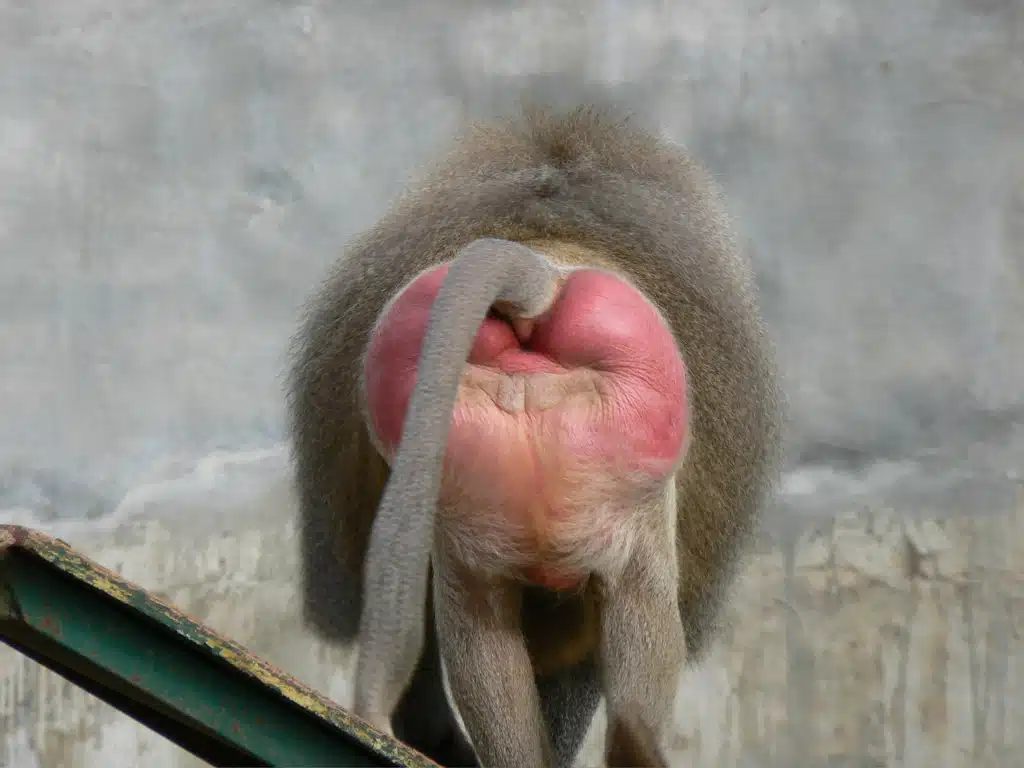
The increased vascularization of the skin on the bottom of monkeys may also be the result of friction. This typically leads to a lesser red nuance than the vivid red nuance of the breeding period.
The skin on the bottom of monkeys is also thicker due to this increased friction.
Here are some of the most common monkeys with red bottoms and what makes them unique.
Monkeys With Red Bottoms
Some of the most recognized monkeys with red butts include the following species.
1. Hamadryas Baboon
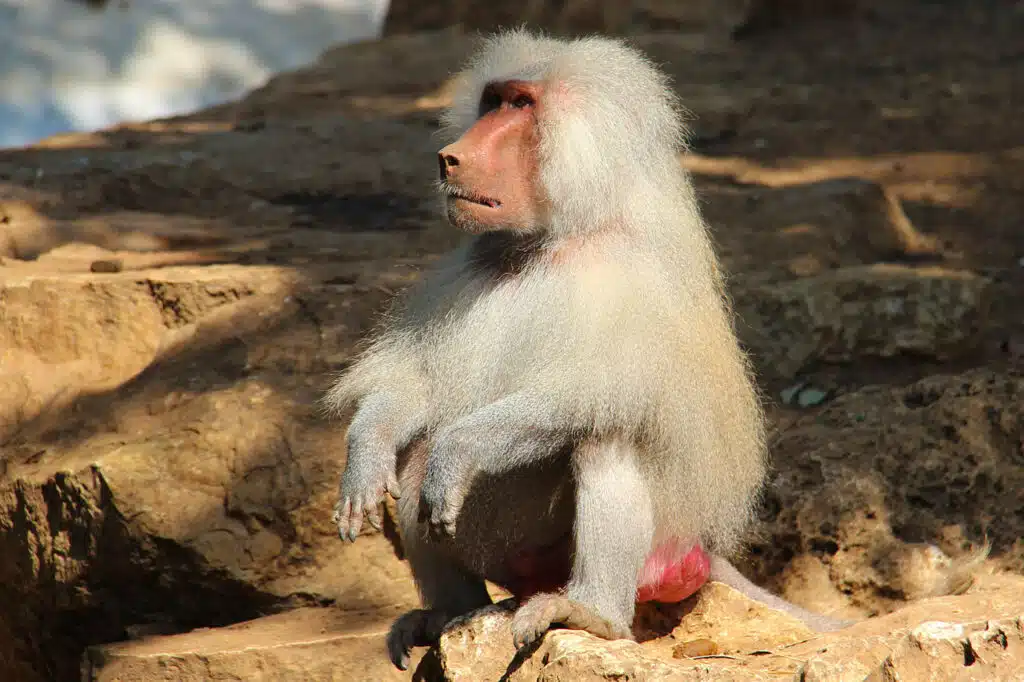
Hamadryas Baboons (Papio hamadryas) are colorful and red-bottomed. Both males and females show bright red bottoms, despite having a different appearance.
Smaller females are brown while males twice their size are silver.
Both males and females show red bums from an early age but males take a few years to get their adult color plus an additional 10 years to show their mantles.
This species has a diverse diet based on fruits and seeds when in season and on evergreen leaves for the rest of the year.
An important species in their cultures, Hamadryas Baboons may also be referred to as Sacred Baboons. They are considered a sacred species in Ancient Egyptian rituals.
The baboons also live in Eritrea and Djibouti, as well as beyond The Red Sea, at the foothills of The Sarawat Mountains.
Hamadryas Baboons live in small groups made up of up to 9 females and one male.
The male is dominant, breeding with all females. Some groups additionally include a younger male, typically the offspring of the dominant male.
These types of baboons are also highly aggressive. They live in harems or small groups of females and a male.
Other types of groups with males alone may raid these harems for females. They essentially take females of a group with them as they travel.
Red-bottomed baboons of the species are typically involved in heavy fights in these takeovers.
Dominant males of a group are known to protect the female from other males. The same levels of protection are attributed to their offspring.
2. Guinea Baboon
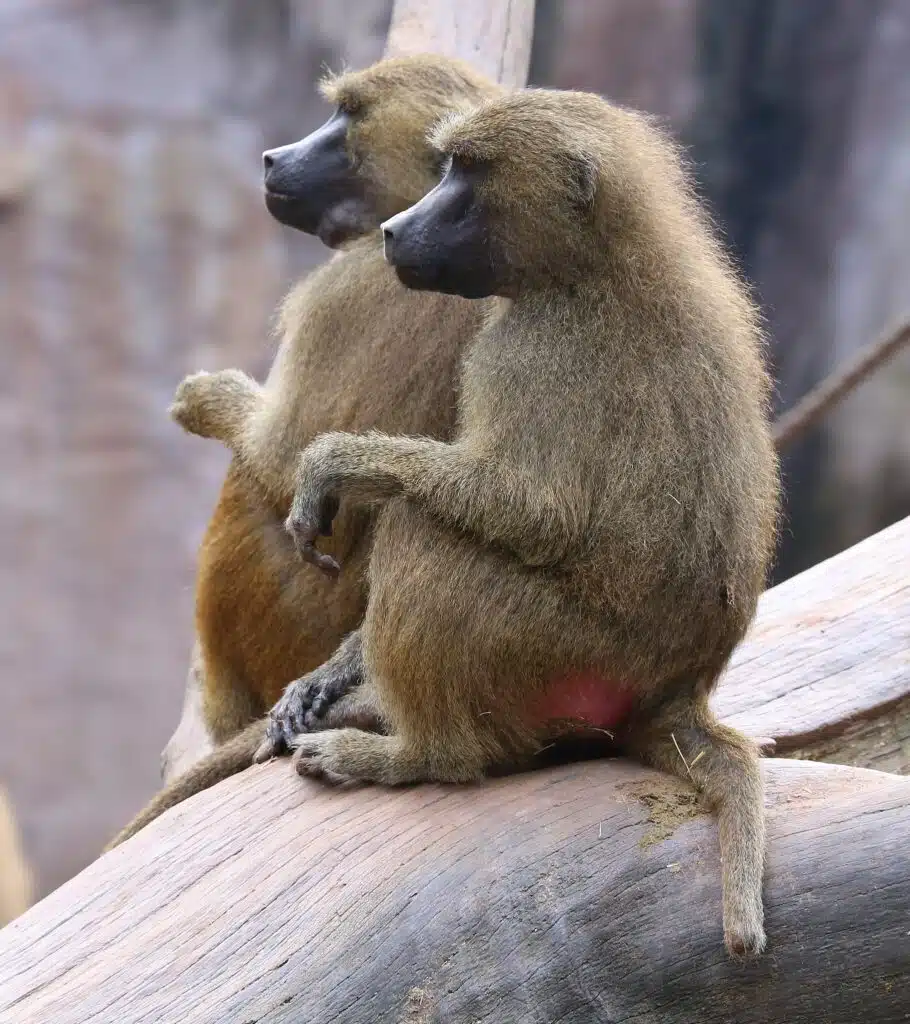
A red-brown color and red bottoms are specific to Guinea Baboons (Papio papio). These types of baboons are hairy except for the face which is black and the red bottom.
Females of the species are particularly known for their red bums.
These types of females enter the breeding period by turning their bottoms red.
A female’s bottom can become red and swollen before the breeding period. Females become red up to 12 days before ready to breed but they remain ready to breed a full week afterward.
A combination of both red bottoms and swollen bottoms signals the female is ready to breed.
Males are also considerably larger than females but also less aggressive than other male monkeys.
These males have been shown to make peace signs to other males whenever in conflict.
West African savannahs are among the most common habitats of the species. These monkeys live in Guinea, Senegal, and Gambia.
A species that is also terrestrial, Guinea Baboons are ready to travel for food. Fruits, seeds, leaves, and small animals can be eaten by these baboons.
Monkeys of the species live in one-male groups where the dominant male breeds with the other females.
Meeting other males is not a time of confrontation as male Guinea Baboons often greet each other in a sign of respect or non-aggression.
Males and females sleep on trees with a clear hierarchy being seen from the area of the trees they sleep on.
Dominant males and females sleep on the largest branches of trees as a sign of dominance.
In the case of a larger group, only dominant males and females get to sleep on the tree.
Guinea Baboon groups can count up to 200 monkeys which means there might not be sufficient room for everybody on a branch.
Sleeping on the ground is considered more dangerous due to the higher number of nighttime predators looking for food at ground level.
3. Japanese Macaque

Humans sometimes interact with monkeys that have red bums. Interactions with Japanese Macaques (Macaca fuscata) are high as these types of monkeys live close to humans in Japan.
Bright red bottoms and matching nuance hairless faces are specific to these monkeys, also known for their love of hot springs’ baths as a means to cope with the cold winters in Japan.
These are also the red-bottomed monkeys that live furthest in the North.
A species with high intelligence, this is a monkey that lives in small groups led by females and a female leader.
Both males and females have red bottoms but females that are younger tend to breed more as they have a higher hierarchy in the group.
Offspring also live with these monkeys within a group. They only live in the group of males reaching an adult age.
Over time, these monkeys have spread throughout Japan. This has led to an increase in their urban presence.
Aggressive at times, these monkeys aren’t afraid to attack humans for food, especially when traveling in groups.
4. Rhesus Macaque
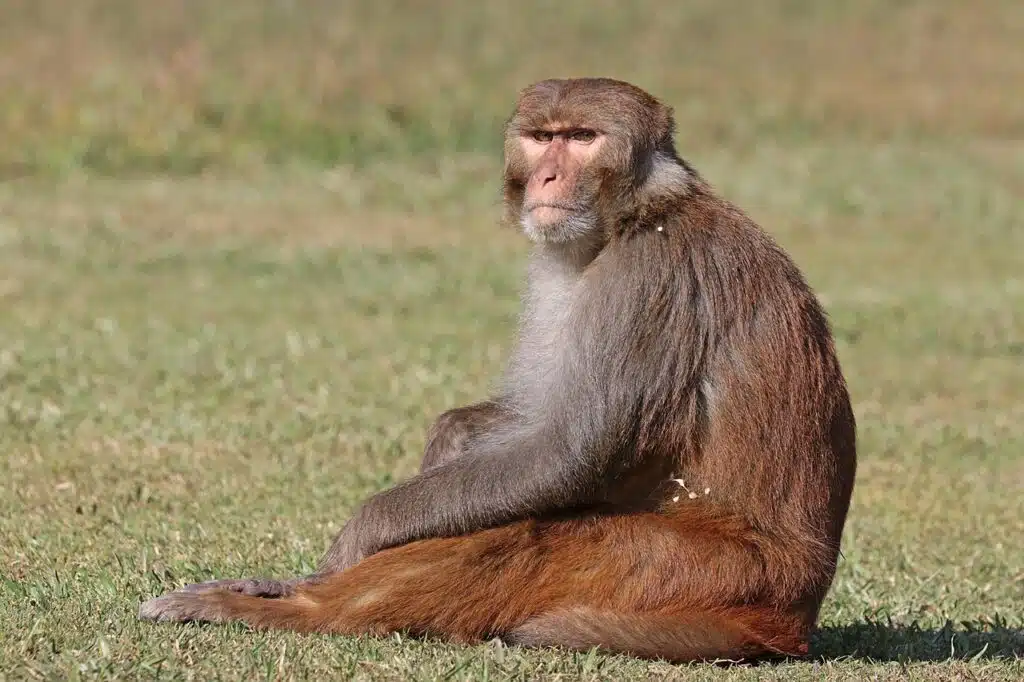
A species with red bottoms, Rhesus Macaques (Macaca mulatta) is also accustomed to living among humans.
India and China are among the countries where these monkeys are present in urban areas. They also live in Thailand, Vietnam, and Laos.
Further known for their long canine teeth, these monkeys have a varied diet and will eat fruit and other foods directly from humans.
Monkeys of the species are rarely seen in cities alone. They typically live in large groups dominated by females.
A single or multiple dominating females are specific to these groups. The hierarchy is inherited by younger females who are considered more fertile and ready to breed.
Communication often exists only between the higher rank hierarchies but there are certain sounds and gestures also specific between the various classes within a group.
Lower-hierarchy monkeys can express fear or respect for higher-hierarchy females by showing their teeth.
Males form short-period relationships with females only within the breeding period. They may breed with other group members afterward.
5. Stump-Tailed Macaque
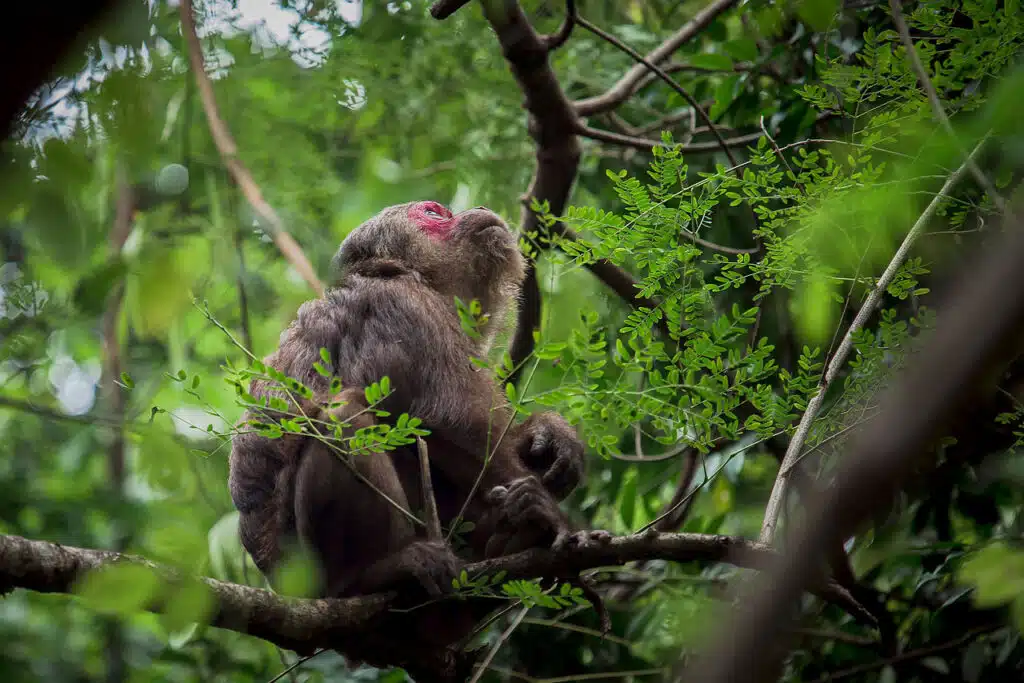
India, China, and Myanmar are some of the countries where Stump-Tailed Macaques (Macaca arctoides) live.
This is a species that shows red bottoms and vivid red faces and which is also easy to spot given the large size of males.
Reaching a size of up to 25 inches, these are some of the largest red-bottomed monkeys in South and Southeast Asia, as well as the world.
Mostly arboreal, these monkeys live in groups where multiple females get certain social roles as they are born, on a hereditary basis.
Despite their size, Stump-Tailed Macaques aren’t aggressive among them and may even be seen as some of the most peaceful monkeys.
Very good communication is attributed to this merit. Males and females often have vocalizations, grimaces, or gestures of peace-making which means they rarely fight and tend to live in harmony for life.
Their non-aggression is also specific to the breeding period. Males and females of a group can breed with multiple partners, without any long-lasting relationships among them.
The rather uninhibited breeding pattern of the species repeats itself each year.
Studies show that males and females who have previously copulated don’t show any preferential treatment towards each other after returning to their group.
6. Celebes Crested Macaque
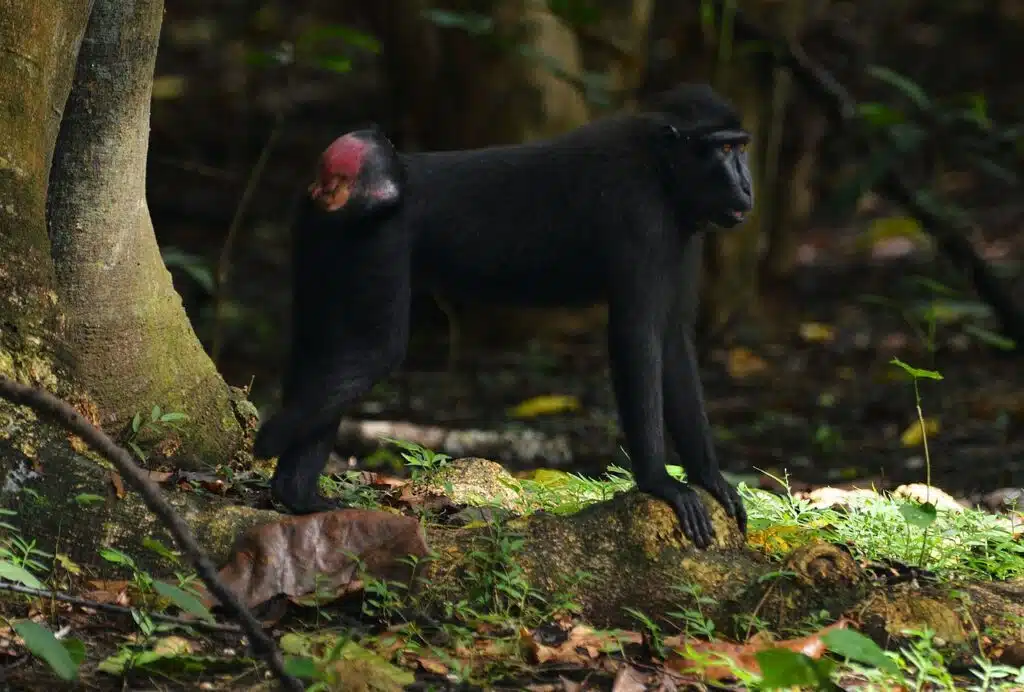
Mostly black, the Celebes Crested Macaque (Macaca nigra) is known for its vivid red bums.
This species is known for its black crest and smiling figure, captured on what is believed to be the first monkey selfie.
The appearance of the red bottom in these monkeys is closely tied to how ready they are to breed.
Females are known to have swollen red bottoms and genitalia going into their breeding period.
Male and female Celebs Crested Macaques can breed with any partner.
Living in small or large groups, these types of monkeys are fans of living with just one or up to 4 males in the group.
Females of the species can breed with any of these males, as do the males.
A species of Indonesian forest within the Tangkoko Nature Reserve, The Celebes Crested Macaques is also one of the endangered red-bottomed monkeys.
Humans are believed to be their largest risk factor as these monkeys are hunted for food locally.
Even the most optimistic estimates show there are only up to 6,000 Celebes Crested Macaques left in the wilderness of Indonesia.
7. Mandrill
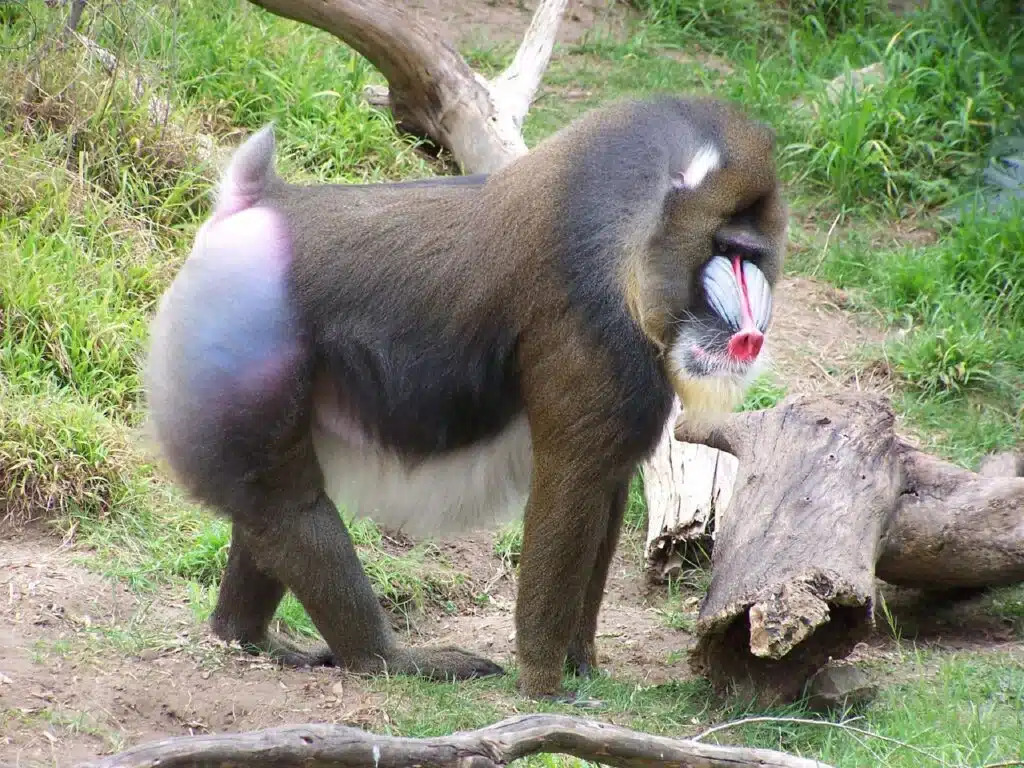
Mandrills (Mandrillus sphinx) are some of the largest monkeys with red bottoms in the world. They also live in some of the larger groups monkeys are known in.
The species showcases red bottoms as well as red and blue face coloring.
Male mandrills tend to be more colorful and their faces stand out first. There’s a red band on the face, running from the eyes to the nose and backed by blue sections on each side.
Red sections on its face and bottom are the result of blood vessels being present near the surface of the skin.
The nuance of their red areas and even the shape of their red areas are further impacted by the role of the monkey such as its status in the pack.
Males fight for hierarchy with other males in one of the longest and often challenging habits of monkeys due to the large number of males that want the alpha status.
Males can gain or lose their alpha status in the group which dictates how their red skin sections look.
An alpha male has redder skin on the bottom and the face. In addition, they also get inflated red genitalia when becoming an alpha male with breeding rights.
This process also has a reverse as males can show pale red sections on the bottoms, genitalia, and face when they aren’t alpha males anymore.
A species of West Africa, these types of monkeys live in groups where they’ve learned to communicate.
Males even make specific vocalizations when on the move, together with the group.
Certain postures and grimaces are also specific to these monkeys which are prevalent in Gabon.
8. Drill
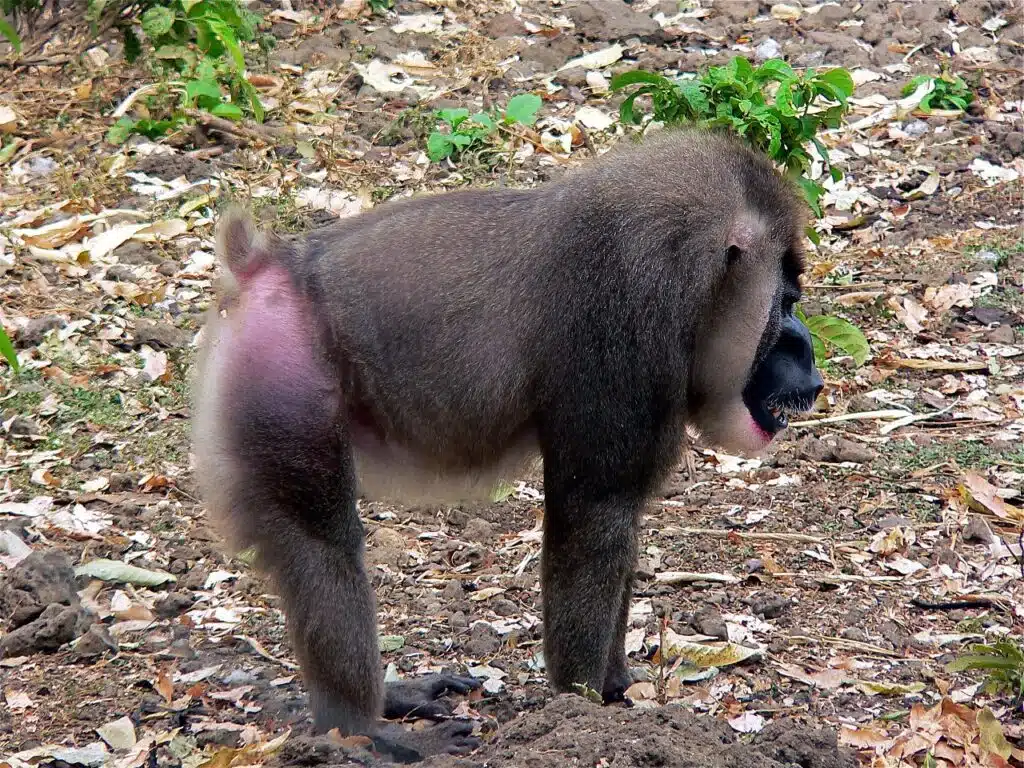
A species under conservation, Drill Monkeys (Mandrillus leucophaeus) are similar to Mandrills. While they lack the red band on the face and nose, they still have red bums.
Some similarities are seen in terms of size and the size differences between males and females.
Drills are also known for living in very large groups. Tens and hundreds of monkeys can form a group within the species.
Males and females live within this group, together with their young.
Nigeria and Cameroon are among the states where these monkeys are found in their highest numbers.
Yellow-brown with black faces, these types of monkeys show variation in their red coloring, according to their breeding status.
The bottom of males becomes both red and blue when ready to mate. Female drills also have red bottoms but they are mostly red and swollen when pregnant.
Breeding and territoriality are important for these semi-terrestrial monkeys. They can move in groups looking for food in different areas.
To mark their territories, these monkeys use their scent glands and often mark trees with their scent by rubbing their chests against bark.
An endangered species, these types of monkeys can live long lives. Males live shorter lives while females have been estimated to live past 40.
9. Olive Baboon
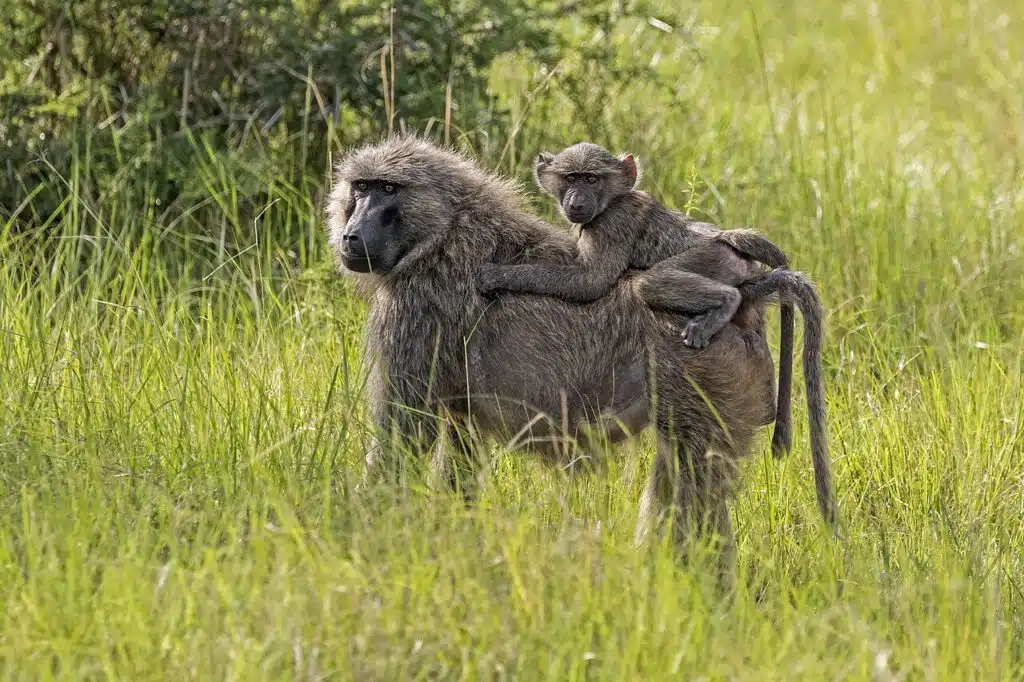
Olive Baboons (Papio anubis) are another species of common monkeys with red bottoms. They only get red bottoms when they’re ready to breed.
Both their bottoms and their genitalia can swell up to mark their breeding readiness.
Olive Baboons have hair-free bottoms which means the red skin patch is visible to everybody.
This is a common physical trait of these baboons, maintained even outside their breeding period.
Bare skin patches at the bottoms of monkeys mean they’re also more vulnerable in this area when sitting down.
Bare skin patches are also specific to their faces. As the skin on their bums, the skin on their faces is also red when breeding or when pregnant before returning to a pink-red nuance or even a gray nuance.
Baboons often spend their time on the ground on different soils. This can cause calluses on their red bottoms but this doesn’t stop them from spreading their habitat across Western, Central, and Eastern African states.
OIive Baboons are ready to breed at least once per year once they become sexually mature.
They might even breed with multiple partners, mostly as a result of living in very large groups.
These types of monkeys have been recorded even in groups of up to 150.
High adaptability is specific to these groups which can move for food. Fruits, leaves, and even small mammals are part of their diet.
Some of the most common areas Oliva Baboons live in are savannahs, grassland, steppes, and forests.
All of these areas come with different food choices
Further adaptations also include the capacity to interbreed with other species in some areas of overlapping habitats.
They can also breed with other types of red-bottom monkeys such as The Hamadryas Baboon.
10. Moor Macaque
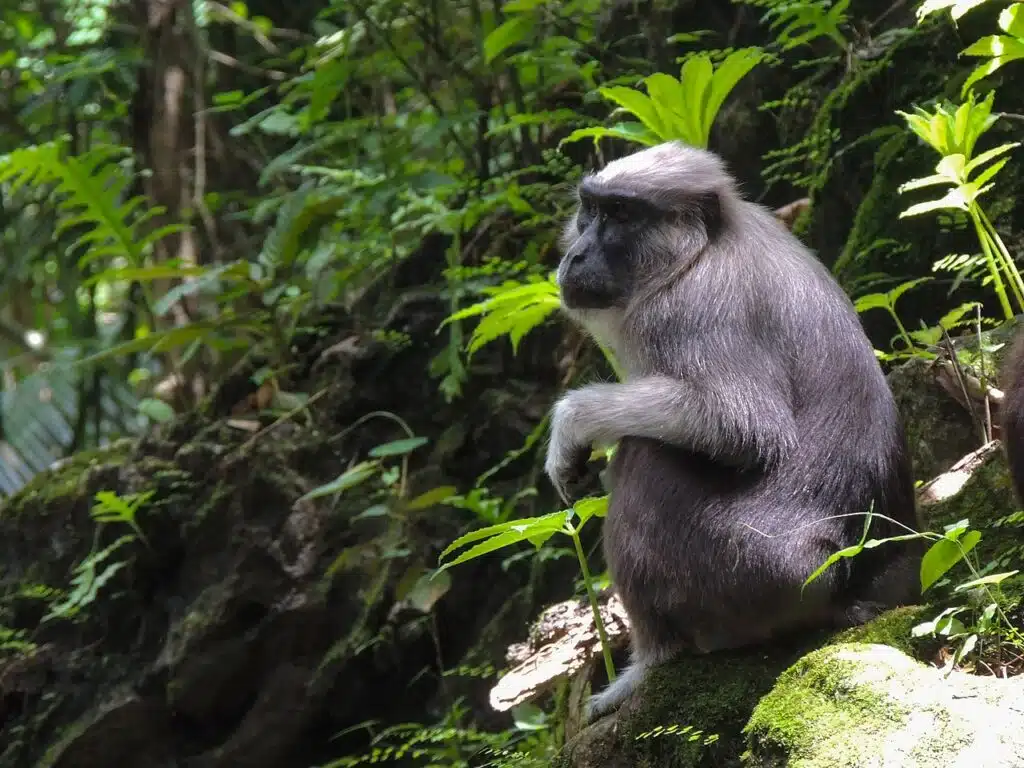
Moor Macaques (Macaca maura) are native to Indonesia. They have red bottoms or thickened bottom exposed skin due to the constant friction.
Types of monkeys with short tails, Moor Macaques are among the species with an endangered status, despite being quite versatile in feeding habits.
Fruits such as figs represent an important part of their diet.
The destruction and fragmentation of their habitat due to mining is a big threat faced by these macaques.
Much of their lives are spent eating. Moor Macaques eat and live in groups, often of up to 43 individuals.
Males and females are part of the group but there’s a hierarchy for them as well. Females tend to breed with the higher-hierarchy males.
It takes at least a few years for females to show their red bottoms swollen as a sign of readiness for breeding.
Female Moor Macaques take at least 4 years to become ready to breed.
Their genitalia and bottoms signal their readiness to breed for a period that lasts 12 days.
Apart from these physical changes, females may also take on different postures or resort to making certain sounds or gestures which may also attract the attention of males within the group.
11. Chacma Baboon
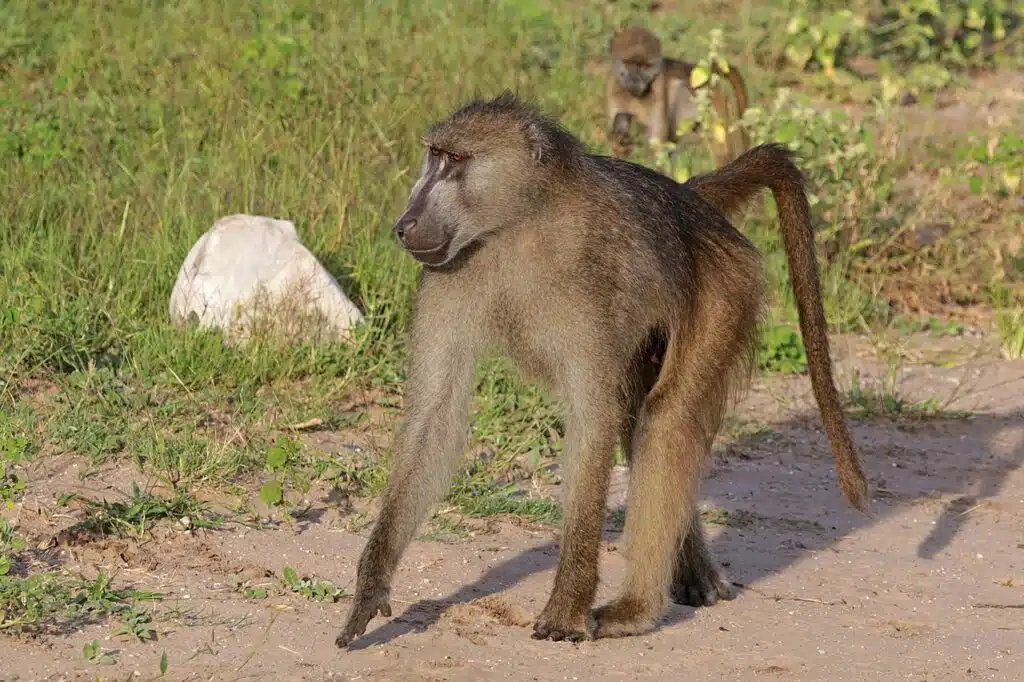
Chacma Baboons (Papio ursinus) are the largest type of monkeys with red bums. They can grow to a length of 50 inches with an additional long tail that makes them even larger than Olive Baboons.
These types of monkeys live in diverse habitats in Southern Africa, often in open spaces.
While large, the monkey cannot defend itself against some of the largest predators in the area, such as leopards.
As a result, it retreats up a tree or in areas above the ground that are difficult to reach at night.
These types of monkeys are known to live in groups where females breed with dominant males and with other males in the group.
High levels of aggression are seen within a group. Alpha males are sometimes interested in killing all offspring when joining a new group after defeating the local alpha male to breed with all females.
In turn, this has triggered the females of a group to form close relationships with other males with a lower group hierarchy.
Females seek out the protection of males in front of new possible alpha males.
The species is facing habitat loss in much of its habitat as it only partly lives in protected areas.
12. Bonnet Macaque
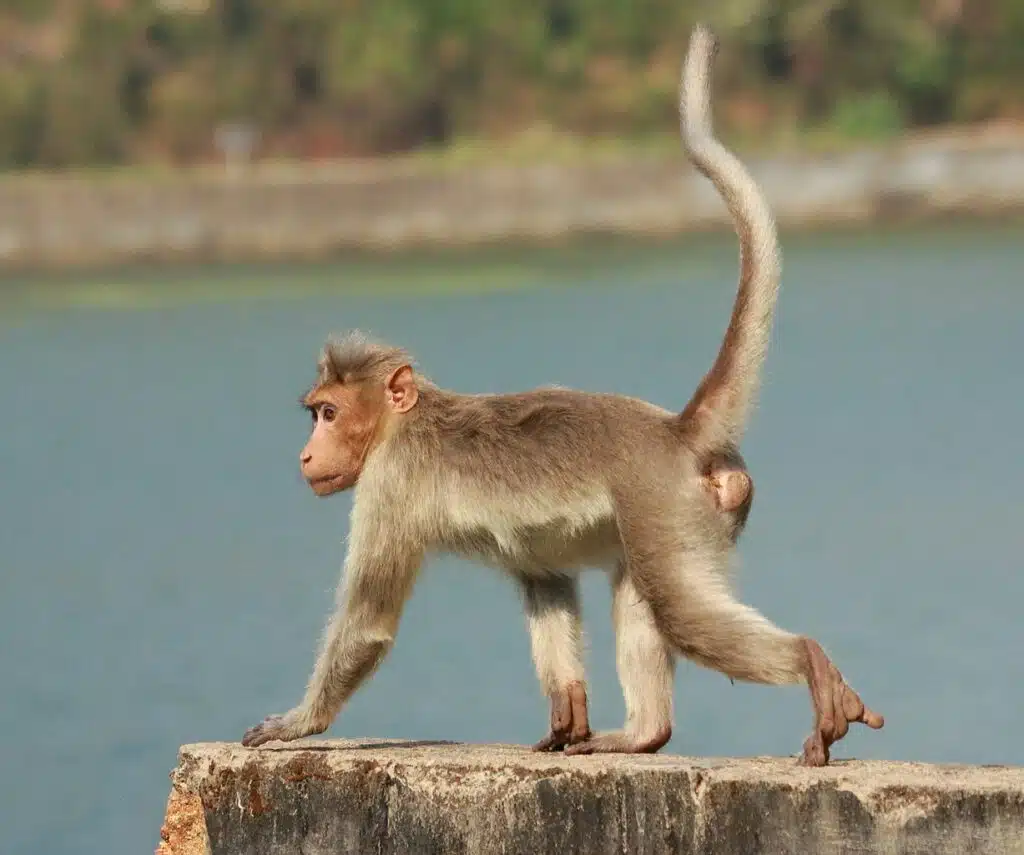
A species with red bottoms, lips, faces, and ears, Bonnet Macaques (Macaca radiata) are natives of India.
Their interactions with humans are constant as these monkeys live in urban areas. High-density areas such as tourist areas attract these monkeys to cities as they receive food from humans.
A common sight around religious temples, these monkeys aren’t afraid to get close to humans.
Bonnet Macaques are a common pest of crops and urban gardens. They can destroy fruits, vegetables, and other goods in their area.
The breeding periods are often the times when the monkeys are spotted in inhabited areas.
Females of the species may breed with multiple males. The male Bonnet Macaque rarely fights other males for breeding rights.
Males are known to have deep bonds, friendship, and respect seen even in their forms of greeting.
Bonnet Macaques live in groups referred to as troops. Each troop numbers up to 30 individuals with a clear hierarchy.
While the elders get the higher hierarchy, this is less of a daily guidance outline for the group as higher levels of friendship are specific to Bonnet Macaques.